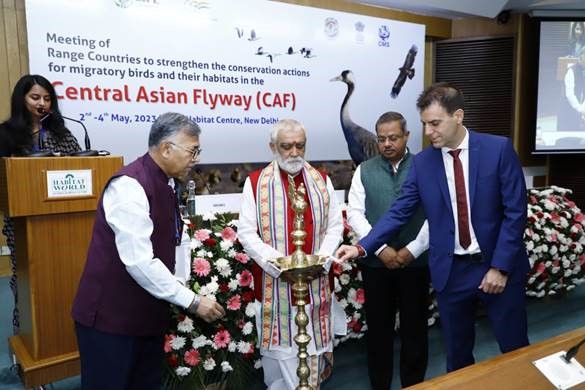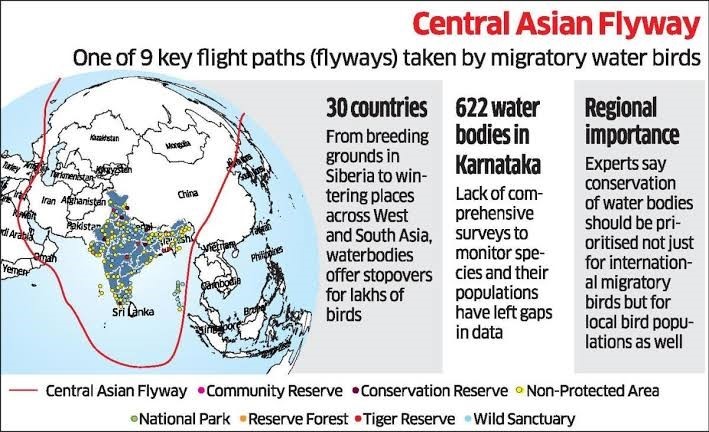Description

Disclaimer: Copyright infringement not intended.
Context
- The Ministry of Environment, Forest and Climate Change in collaboration with the United Nations Environment Programme/ Convention on Migratory Species (UNEP/CMS) had organized a meeting of Range Countries to strengthen conservation efforts for migratory birds and their habitats in the Central Asian Flyway (CAF) from 2ndto 4th May, 2023 in New Delhi.
Details
Participants
- The meeting was attended by the eleven countries of CAF region including Armenia, Bangladesh, Kazakhstan, Kyrgyzstan, Kuwait, Mongolia, Oman, Saudi Arabia, Tajikistan, and Uzbekistan,
- Participants also included the Secretariats of CMS, AEWA and Raptors MOU, and representatives of Chief Wildlife Wardens of States, scientific institutions in India, international and national non governmental organizations, and subject experts

About Central Asian Flyway
- The Central Asian Flyway (CAF) covers a large continental area of Eurasia between the Arctic and Indian Oceans and the associated island chains.
- The Flyway comprises several important migration routes of waterbirds, most of which extend from the northernmost breeding grounds in the Russian Federation (Siberia) to the southernmost non-breeding (wintering) grounds in West and South Asia, the Maldives and the British Indian Ocean Territory.
- Geographically the flyway region covers 30 countries of North, Central and South Asia and Trans-Caucasus.
- The CAF covers at least 279 populations of 182 migratory waterbird species, including 29 globally threatened and near-threatened species, which breed, migrate and winter within the region.
Challenges
- Many waterbird populations are declining rapidly and the wetlands, grasslands and other habitats upon which they depend are seriously threatened along the CAF due to uncontrolled hunting, habitat degradation, unsustainable water management, and lack of law enforcement and conservation capacity.
Species
- CAF migration routes include the steppes and cold deserts of Central Eurasia, and much of the Himalayan chain, where unique, high-altitude migrations such as those of the Bar-headed Goose, Anser indicus, take place.
- Other Central Asian species for which the new CAF Action Plan should have the greatest significance are: Asiatic Dowitcher (Limnodromus semipalmatus), Black-necked Crane (Grus nigricollis), Indian Skimmer (Rynchops albicollis), Ibisbill (Ibidorhyncha struthersii), Brown-headed Gull (Larus brunnicephalus), Siberian Crane (Leucogeranus leucogeranus), Sociable lapwing (Vanellus gregarius), Spot-billed Pelican (Pelecanus philippensis), Relict Gull (Larus relictus), Black-winged Pratincole (Glareola nordmannii) and Caspian Plover (Charadrius asiaticus).
Background
- There is an urgent need for science-based and internationally coordinated conservation measures, ensuring the survival of species and their habitats as well as sustainable benefits to people.
- In order to address those needs and to identify coordinated actions to conserve those species, CMS convened three meetings of range states (Tashkent 2001, New Delhi, 2005 and Abu Dhabi, 2012).
- The second meeting in New Delhi (2005) broadly agreed on the content of the Central Asian Flyway Action Plan to Conserve Migratory Waterbirds and their Habitats.
- The Action Plan has been developed with technical support from Wetlands International and was finally adopted in January 2008 after incorporation of further technical comments received following the Meeting.
- The Action Plan provides the basis for the 30 Range States to take individual and coordinated region-wide activities to conserve waterbirds and their habitats.
- It covers 175 species of divers, grebes, pelicans, cormorants, herons, storks, ibises, flamingos, geese, cranes, rails, sun grebes jacanas, crab plovers, oystercatchers, stilts and avocets, pratincoles, plovers, scolopacids, gulls and terns.
- Thirteen of the species are already listed on Appendix I of the Convention.
- It contains provisions for species and habitat conservation, single species action plans and emergency measures.

Threats along the Flyway
- Unfortunately, many of the world’s migratory birds are in decline.
- Many characteristics of migrants render them particularly vulnerable to a variety of threats.
- Undertaking such dramatic movements pushes birds to the limit of their endurance. They are reliant on favourable weather conditions and must find sufficient food resources at multiple sites throughout their migratory journey.
- Over the full length of the flyway, important habitats for migratory birds are being rapidly degraded by a range of anthropogenic threats.
- Larger migrants are also at risk through collision with man-made structures such as powerlines. Furthermore, poorly designed medium-voltage lines pose a significant risk of electrocution for large perching species like raptors.
- In the face of such a diverse array of threats the conservation of migratory birds depends on international collaboration and a coordinated response along entire flyways.
- BirdLife International’s Important Bird Areas (IBAs) programme provides the foundations for effective conservation action.

What is a Flyway?
- A flyway is the whole area covered by a species or population of migratory birds over the course of the annual cycle, including breeding and non-breeding grounds and the connecting migration routes.
Types
Flyways of the Americas
- The Atlantic Flyway starts in northern Canada and Greenland and follows the Atlantic coast of Canada and the United States to the Caribbean Sea, and on to tropical South America.
- The Mississippi Flyway starts from northeastern Canada and passes over the Great Lakes, following the lower Ohio River, the Missouri and the Mississippi to the Gulf of Mexico, and on to Central and South America. There are no mountain barriers on this route.
- The Central Flyway starts from central Canada and crosses the Great Plains before continuing southwards to the Gulf of Mexico, merging with the Mississippi Flyway. There are no mountain barriers on this route.
- The Pacific Flyway is a north–south flyway for birds migrating from breeding grounds in Alaska and Canada to their overwintering areas in South America, some species travelling as far south as Patagonia.
- The Allegheny Front flyway in the central Appalachian Mountains is an important flyway for migratory birds traveling from their northern breeding grounds to their southern wintering sites.
Flyways of Eurasia, Africa, and Australasia
- The East Atlantic Flyway starts from northern North America, Greenland, Iceland, northern Europe and western Siberia and leads to wintering areas in western Europe and North Africa, with some birds continuing down the west coast of the continent to South Africa.
- The Black Sea-Mediterranean Flyway starts from northern and western Siberia and leads across Asia, the Black Sea and the Mediterranean Sea to northern Africa. Little has been published about birds using this flyway.
- The Asian–East African Flyway starts from the northern breeding grounds of water birds in Siberia and leads across Asia to East Africa. Little has been published about birds using this flyway.
- The Central Asian-Indian Flyway starts from the northern breeding grounds of water birds in Siberia and leads across Asia to the Indian subcontinent. Little has been published about birds using this flyway.
- The East Asian–Australasian Flyway starts at the Taymyr Peninsula in Russia and Alaska and extends southwards to southeastern Asia, Australia and New Zealand. This flyway overlaps with the West Pacific Flyway. About 60 species of shorebird use this route.
- The West Pacific Flyway links New Zealand and the east coast of Australia, through the central Pacific Ocean and the east coast of northern Asia, including Japan and the Korean Peninsula, ending up in eastern Siberia, including the Chukchi and Kamchatka peninsulas, and Alaska. This flyway overlaps with the East Asian–Australasian Flyway.
|
PRACTICE QUESTION
Q) What do you mean by the term flyway? Discuss in brief the various types of flyways in the world. (250 words)
|

https://pib.gov.in/PressReleasePage.aspx?PRID=1922271













